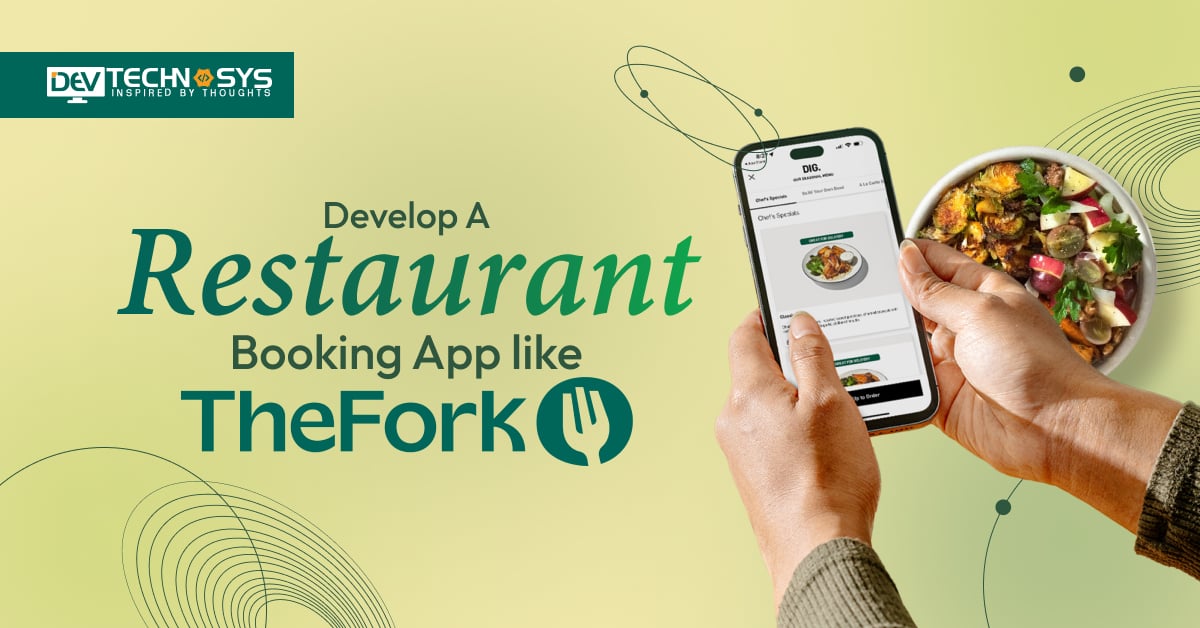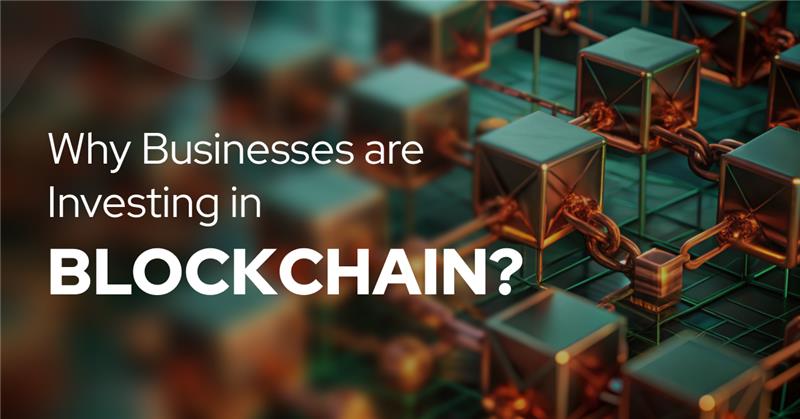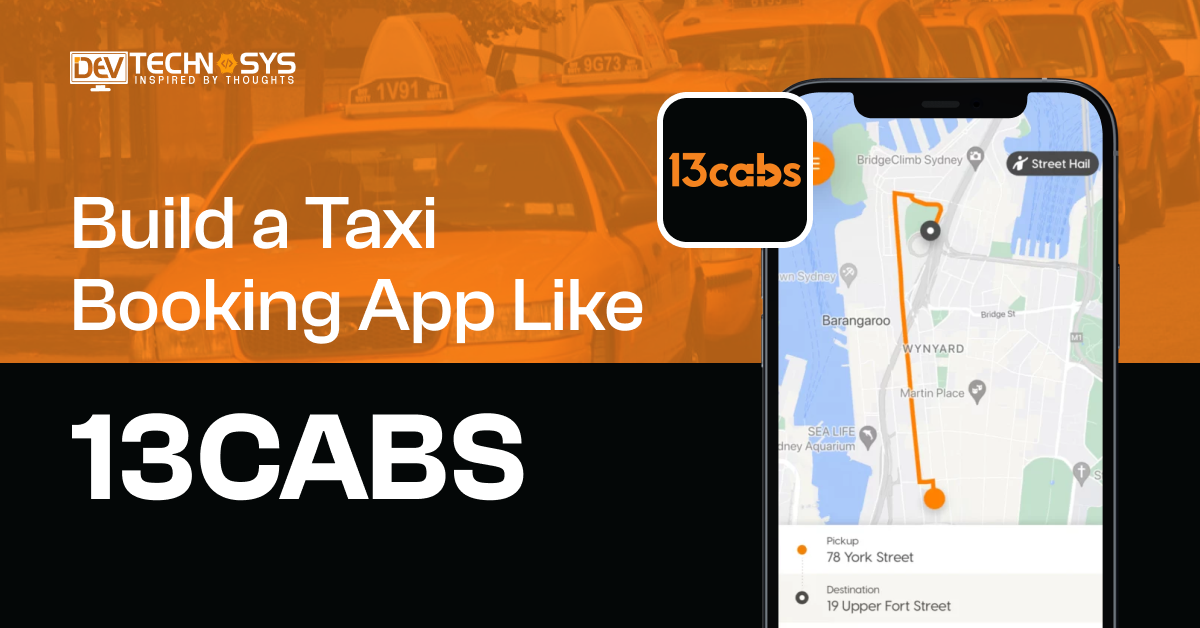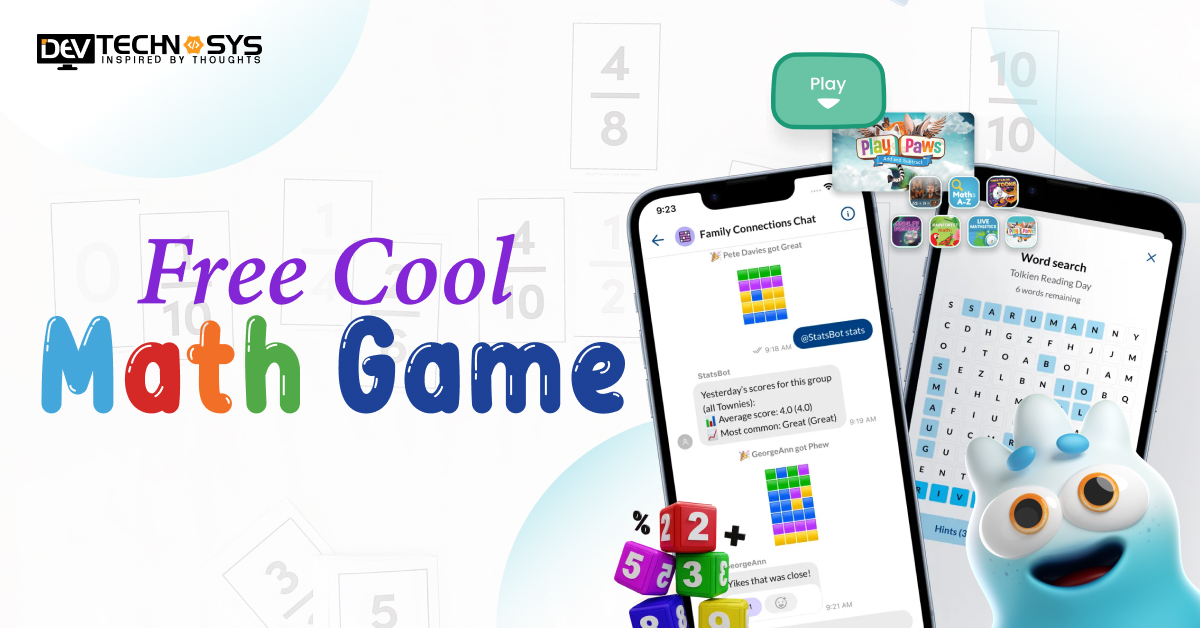Have you ever wished you could book a table at your favorite restaurant in just a few taps?
Apps like TheFork make that possible, and in today’s digital world, building your own restaurant booking app is not only exciting but also very useful.
Whether you’re a tech enthusiast and a future app developer, understanding how these apps work can be a great experience.
Key takeaways:
-
- The market for restaurant management software is expected to grow from its 2024 valuation of USD 5.79 billion to USD 14.70 billion by 2030.
- Platforms like TheFork, OpenTable, and Resy offer a model for scalable, secure, and user-focused restaurant booking ecosystems.
- Monetization through commission-based bookings, premium listings for restaurants, and advertising offers scalable business models.
- Seamless API integrations with POS systems and third-party apps (like payment gateways or review platforms) are key for operational efficiency.
In this guide, I’ll explain how to develop a restaurant booking app like TheFork, from the features you need to the technology behind it.
You’ll learn about user-friendly design, real-time reservations, reviews, and payment systems that make the app smooth and helpful.
I believe that anyone with an interest and curiosity can explore app development.
So let’s dive into the world of restaurant apps and see how one is made!
Global Market Projections of Restaurant Booking Applications
- From 2025 to 2030, the European restaurant management software industry is expected to increase significantly.
- In 2024, North America had the most market share, accounting for over 32%.
- The market is divided into two segments based on deployment: on-premise and cloud. With a market share of more than 54.0% in 2024, the cloud sector had the highest share.
- In 2024, the front-end software category held a market share of more than 34%, according to type.
- The worldwide restaurant management software market was worth USD 5.79 billion in 2024 and is expected to reach USD 14.70 billion by 2030, expanding 17.4% from 2025 to 2030.
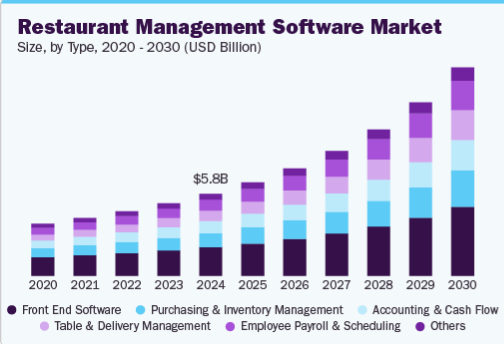
What is TheFork?
TheFork is a restaurant booking app that allows users to discover, reserve, and review restaurants online. It offers real-time table availability, user reviews, menus, photos, and exclusive discounts. Available in multiple countries, TheFork connects diners with thousands of restaurants, making reservations fast and easy. Cross-city food ordering apps like TheFork provide tools to manage bookings, optimize occupancy, and attract more customers through promotions and visibility on the platform.
User Case Study: TheFork
- Founded in 2007 in Paris, TheFork began as a digital solution to streamline restaurant reservations and reduce no-shows for restaurant owners.
- Acquired by TripAdvisor in 2014, it significantly boosted its international reach, credibility, and integration with one of the largest travel platforms.
- Operates in over 12 countries, including France, Spain, Italy, and Australia, helping users book at more than 60,000 partner restaurants globally.
- Offers exclusive discounts up to 50%, driving customer traffic during low-demand hours while increasing restaurant visibility and occupancy rates.
- TheFork Festival and YUMS loyalty program incentivize users to book more frequently, creating customer stickiness and brand loyalty in a competitive market.
- App downloads exceeded 30 million, reflecting strong user demand for convenient, real-time table booking solutions across multiple cities and cuisines.
Different Types of Restaurant Booking Apps
Explore the different types of restaurant booking apps. Learn how each app helps users book tables, find deals, and how restaurants use them to manage reservations and attract customers.
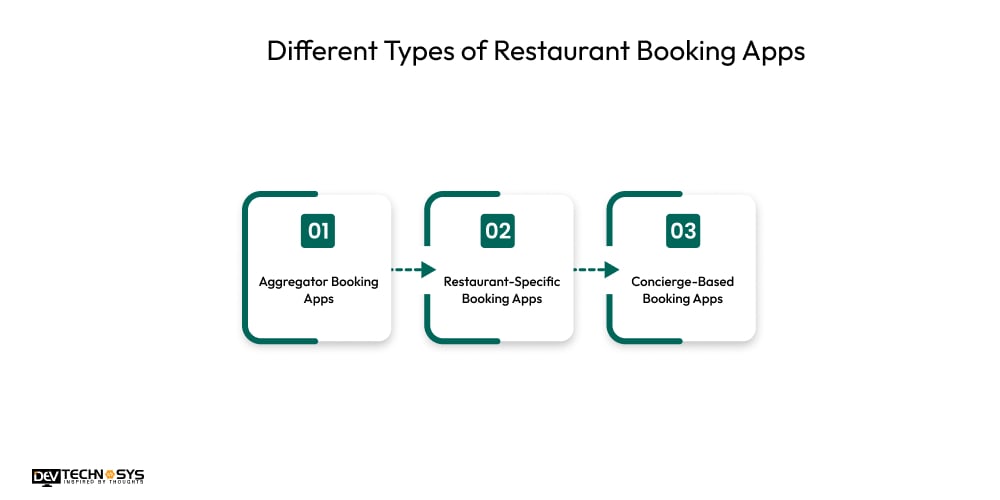
1. Aggregator Booking Apps
These food ordering apps offer a diverse range of restaurants, enabling users to browse menus, read reviews, and make reservations. Examples are OpenTable and TheFork. They assist both users and businesses by raising exposure and filling tables during non-peak hours.
2. Restaurant-Specific Booking Apps
These applications, designed for certain restaurant brands or chains, include direct bookings, menu browsing, and loyalty benefits. Examples of applications suitable for client retention and brand control include those from Olive Garden, Chili’s, and premium fine-dining restaurants.
3. Concierge-Based Booking Apps
These premium services appeal to affluent customers by providing exclusive access, last-minute reservations, and tailored suggestions. Examples of lifestyle services or credit cards are Resy Select and Amex Global Dining Access.
10 Best Restaurant Booking Apps like TheFork
Discover the best restaurant booking and food delivery apps that help users find, reserve, and enjoy dining experiences while supporting restaurants with smart reservation management tools.
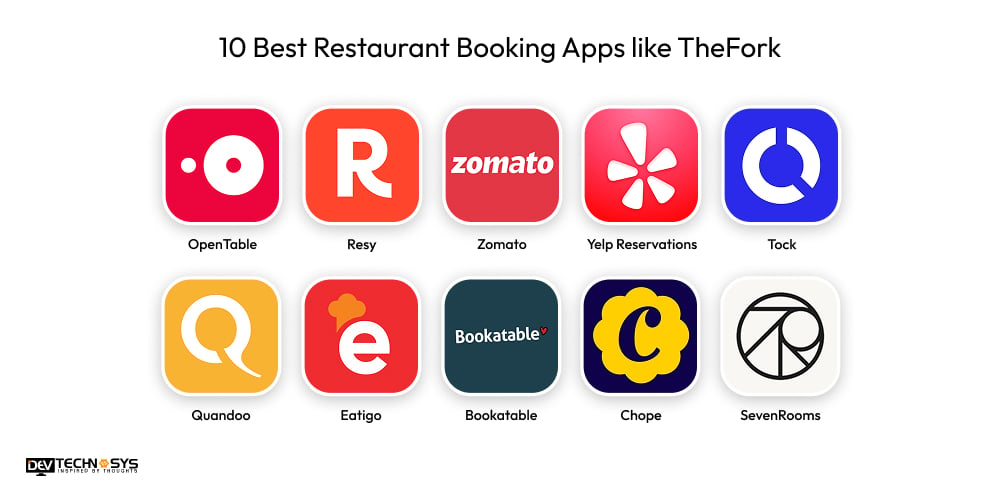
| App Name | Approx. Downloads | Avg. Rating | Launch Year | Platform Availability |
| OpenTable | 50M+ | 4.8 | 1998 | Android, iOS, Web |
| Resy | 5M+ | 4.6 | 2014 | Android, iOS, Web |
| Zomato | 100M+ | 4.3 | 2008 | Android, iOS, Web |
| Yelp Reservations | 10M+ | 4.5 | 2010 | Android, iOS, Web |
| Tock | 2M+ | 4.4 | 2014 | Android, iOS, Web |
| Quandoo | 10M+ | 4.5 | 2012 | Android, iOS, Web |
| Eatigo | 5M+ | 4.2 | 2013 | Android, iOS, Web |
| Bookatable | 3M+ | 4.3 | 2006 | Android, iOS, Web |
| Chope | 5M+ | 4.4 | 2011 | Android, iOS, Web |
| SevenRooms | 1M+ | 4.6 | 2011 | iOS, Web (limited Android) |
Why Entrepreneurs Want to Invest in Restaurant Booking App Development?
In today’s fast-paced digital world, similar app like TheFork have revolutionized how customers discover and reserve tables. Entrepreneurs are increasingly attracted to this sector due to several compelling reasons:
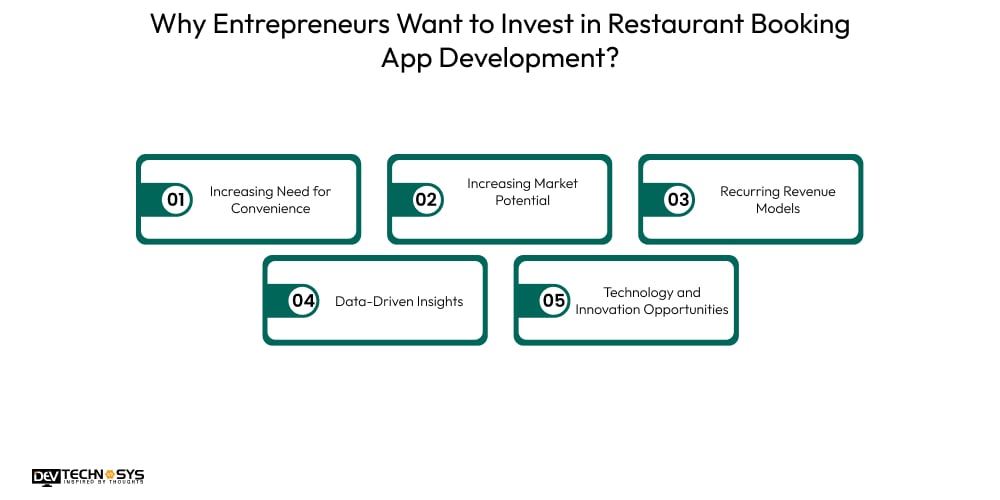
1. Increasing Need for Convenience
Consumers seek convenience and fast pleasure. Restaurant booking apps like Seamless allow users to search, book, and manage reservations at any time and from any location, eliminating the need for phone calls or waiting in queues. This move toward more convenient eating experiences increases demand and generates profitable business opportunities.
2. Increasing Market Potential
The worldwide internet foodservice sector is thriving, with millions of people depending on applications to make eating decisions. This growing user base creates substantial growth potential. Entrepreneurs see opportunities to capture varied consumers, ranging from casual eaters to fine dining connoisseurs, across numerous regions.
3. Recurring Revenue Models
Many booking apps like Deliveroo earn consistent revenue through restaurant commission fees, subscription programs, or premium user features. This recurring income stream appeals to investors seeking scalable and long-term business strategies that expand with user engagement.
4. Data-Driven Insights
A booking app for restaurants collects vital client information, including preferences, habits, and peak eating hours. Entrepreneurs see the value of this data in refining marketing tactics, personalizing user experiences, and providing targeted promotions, giving their applications a competitive advantage.
5. Technology and Innovation Opportunities
The industry is ready for innovation, including AI-powered tailored suggestions, real-time table availability, contactless payments, and loyalty programs. Entrepreneurs are thrilled about the opportunity to develop a restaurant booking app like OpenTable that will alter traditional eating and increase user engagement.
How Can AI Improve the Operations of Restaurant Booking Apps?
- AI analyzes user preferences to offer personalized restaurant recommendations, enhancing customer satisfaction and engagement.
- Automated chatbots provide instant customer support, answering queries and managing bookings efficiently 24/7.
- AI predicts peak booking times, helping restaurants optimize table management and reduce wait times.
- Smart pricing models use AI to suggest dynamic pricing or discounts, maximizing restaurant revenue and occupancy.
- AI-driven fraud detection safeguards user data and prevents fraudulent bookings or payments.
- Voice recognition integration enables hands-free booking, improving accessibility and user convenience.
7 Robust Steps to Develop a Restaurant Booking App like TheFork
Discover the essential steps to develop a restaurant booking app like TheFork, covering market research, feature planning, UI/UX design, tech stack, development, integration, testing, launch, and post-launch support. So, here we offer a robust restaurant booking mobile app development process:

1. Conduct Market Research
Start by analyzing competitors like TheFork, OpenTable, and Resy. Understand user needs, market gaps, and regional dining behaviors. Hire mobile app developers to define your app’s target audience, value proposition, and business goals. This foundational research ensures your product offers a unique edge while solving real problems for diners and restaurants.
| Who is our target audience? |
| What are their dining habits? |
| What gaps exist in the current market? |
2. Choose the Right Business Model
In the second stage to develop an app like TheFork, select a sustainable monetization strategy; options include commission per booking, freemium plans for restaurants, ads, or subscription tiers. The model should align with your app’s scalability and user experience. Clearly defining this helps guide development priorities, partnerships, and pricing decisions from the very beginning of the project lifecycle.
| Should we charge restaurants a commission or a subscription fee? |
| How will the app generate revenue? |
| Are there opportunities for partnerships or affiliate programs? |
3. Core Features and App Architecture
Outline essential features: user registration, real-time booking, restaurant profiles, reviews, loyalty rewards, push notifications, and payment integration. Hire dedicated developers to design a scalable backend to manage user data, reservations, and analytics. A strong architectural foundation ensures smooth performance, easy maintenance, and future integration with APIs or third-party systems like POS.
| What are the must-have features for MVP? |
| Will the app support user profiles and reviews? |
| What backend infrastructure will handle data and scalability? |
4. Design UI/UX
Focus on intuitive navigation, appealing visuals, and seamless booking flows. Use wireframes and prototypes to validate user experience before development. Ensure the design supports both diners and restaurant owners with tailored dashboards. A great UI/UX significantly improves user retention, satisfaction, and app adoption across different demographics and platforms.
| What feedback or notifications will users receive? |
| What user flows need to be simple and intuitive? |
| What visual style fits our brand and audience? |
5. Develop the App with Technology Stack
Let’s move to the fifth stage to build an app like TheFork, choose the right tech stack (e.g., Flutter or React Native for mobile, Node.js for backend). Ensure database, APIs, and servers handle real-time updates and user traffic. Prioritize security and data protection. Hire experienced developers from a mobile app development company to use agile development to build an MVP first, allowing for rapid iterations and feature enhancements over time.
| Which platforms will we support first (iOS, Android, web)? |
| What programming languages fit our needs best? |
| What cloud services or hosting will we use? |
6. Integrate Third-Party Services
Add services like Google Maps, Stripe, or PayPal for payments, restaurant POS systems, and review platforms. These integrations improve functionality and user experience. Proper API management ensures performance, compatibility, and smooth updates. Test thoroughly to avoid issues in booking flows, payment processing, or location-based recommendations during real-world usage.
| Which payment gateways should we support? |
| Should we integrate SMS or email notification providers? |
| Which authentication services (OAuth, social login) will we use? |
7. Test, Launch, and Maintain
In the last stage to create an app like TheFork, conduct extensive QA testing, covering usability, performance, security, and cross-device compatibility. Assemble a skilled development team from an Android app development company to launch the app with a soft rollout or beta release. Gather feedback, analyze user behavior, and release updates regularly.
| What types of testing are essential (unit, integration, UI)? |
| What’s the rollout plan for launching the app? |
| What’s the strategy for ongoing maintenance and support? |
Why Users Choose TheFork Over Other Restaurant Booking Apps?
Discover how TheFork’s extensive restaurant choices, exclusive discounts, real-time availability, and intuitive user experience make it the top choice for seamless and rewarding dining reservations over other booking apps.
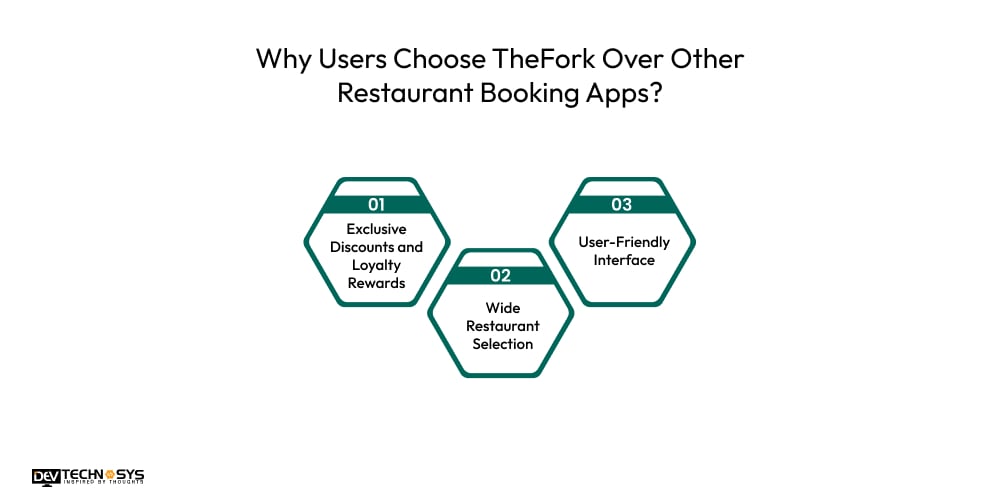
1. Exclusive Discounts and Loyalty Rewards
Users love TheFork due to its appealing specials and exclusive discounts on reservations, which help them save money while dining out. Furthermore, TheFork’s loyalty program rewards regular customers with points that can be used for future discounts, promoting customer retention and making it a more cost-effective option than other restaurant booking platforms.
2. Wide Restaurant Selection
An app like Beyond Menu and TheFork offers a broad network of partner restaurants across numerous locations, ensuring that users have a variety of dining options. Its real-time table availability system ensures accurate booking confirmations, lowering the likelihood of overbooking or cancellations, fostering great confidence and convenience for consumers looking for hassle-free eating experiences.
3. User-Friendly Interface
TheFork’s user-friendly app design provides easy navigation, quick search filters, and a simple reservation procedure. When combined with thorough restaurant descriptions, user ratings, and images, this results in a straightforward and engaging experience that simplifies decision-making, making TheFork a favored app for diners who value convenience and efficiency.
10 Normal and Advanced Features of a Restaurant Booking Apps like TheFork
These features collectively create a seamless, efficient, and engaging booking experience, helping apps like TheFork lead the market in restaurant reservations.
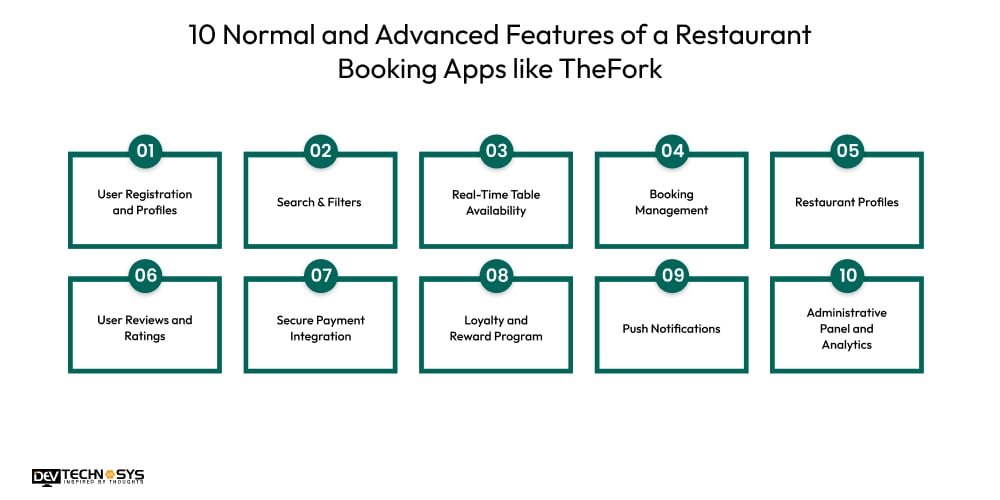
1. User Registration and Profiles
An app like Menulog allows consumers to create accounts, manage reservations, and customize preferences for a more personalized eating experience.
2. Search & Filters
TheFork alternatives allow users to quickly find the ideal restaurant by utilizing advanced search options that include criteria such as cuisine, location, price range, rating, and availability.
3. Real-Time Table Availability
Apps to book restaurants allow customers to book promptly and avoid multiple reservations or delays.
4. Booking Management
Users may simply create, change, or cancel reservations with the app, which includes automatic confirmation alerts and reminders.
5. Restaurant Profiles
A similar app like TheFork provides detailed listings with menus, images, hours of operation, contact information, and user reviews, giving extensive information to help you make decisions.
6. User Reviews and Ratings
An app like ChowNow allows diners to offer comments and grade their experience, which promotes openness and helps others make informed decisions.
7. Secure Payment Integration
TheFork alternatives support several payment options, such as credit cards, digital wallets, and in-app purchases, to ensure smooth and safe transactions.
8. Loyalty and Reward Program
Encourage return visits by providing points, discounts, or special incentives redeemable at participating establishments.
9. Push Notifications
TheFork clone app provides timely notifications regarding booking confirmations, special specials, and tailored suggestions.
10. Administrative Panel and Analytics
An app like SkipTheDishes provides restaurant owners and app administrators with options to manage listings, check booking information, and evaluate user behavior.
What is the Cost to Develop a Restaurant Booking App like TheFork?
The cost to build a restaurant booking app like TheFork typically ranges from $8,000 to $25,000, depending on features, platform choice (iOS, Android, web), design complexity, and development team location.
Basic apps with essential features cost less, while advanced functionalities like real-time availability, payment integration, AI recommendations, and multi-language support increase restaurant mobile app development costs. Ongoing costs for maintenance, updates, and marketing should also be considered for a successful long-term launch.
| Development Aspect | Estimated Cost (USD) |
| Basic Features (MVP) | $5,000 – $12,000 |
| Advanced Features | $10,000 – $18,000 |
| UI/UX Design | $5,000 – $10,000 |
| Backend Development | $10,000 – $16,000 |
| Payment Integration | $3,000 – $7,000 |
| Testing & QA | $5,000 – $8,000 |
| Deployment & Launch | $2,000 – $5,000 |
| Maintenance & Updates (annual) | $3,000 – $10,000 |
Total Estimated Cost: $8,000 – $25,000
5 Major Factors That Impact the Restaurant Booking App Development Cost
Explore the major factors that influence the cost to develop a restaurant booking app like TheFork. It includes feature complexity, platform selection, design quality, development team location, and ongoing maintenance. Each is playing a key role in determining the total investment needed for a successful app launch.
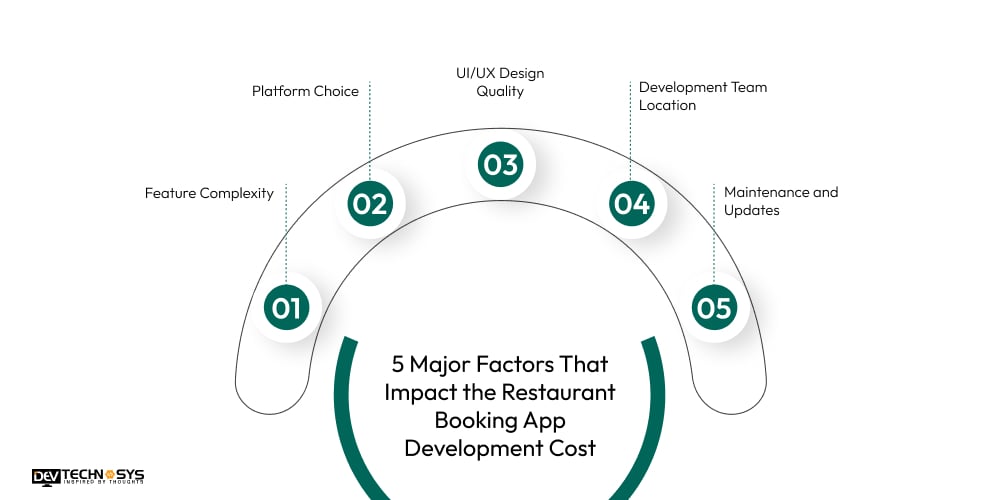
1. Feature Complexity
The amount and complexity of features, such as real-time table availability, payment methods, user ratings, and AI suggestions, directly affect mobile app development cost. More complex features need greater design, development, and testing resources, increasing the price as compared to a basic software with fundamental functionality.
| Feature Set | Estimated Cost (USD) |
| Basic Booking Features (MVP) | $15,000 – $30,000 |
| Advanced Filters & Reviews | $5,000 – $10,000 |
| Real-Time Table Management | $5,000 – $10,000 |
| Loyalty & Rewards System | $3,000 – $7,000 |
| AI-based Recommendations | $7,000 – $12,000 |
2. Platform Choice
Developing for various platforms (iOS, Android, and web) increases expenses because each requires unique code and testing. Native apps often provide superior performance but are more expensive than cross-platform solutions. The decision to launch on one or numerous platforms has a substantial impact on the entire restaurant booking app development cost.
| Platform | Estimated Cost (USD) |
| iOS App (Native) | $15,000 – $30,000 |
| Android App (Native) | $15,000 – $30,000 |
| Cross-Platform (Flutter/React) | $20,000 – $35,000 |
| Web Portal (Admin/Restaurant) | $10,000 – $20,000 |
3. UI/UX Design Quality
High-quality, user-friendly, and visually appealing designs require professional designers and more effort. Custom animations, smooth navigation, and flexible layouts raise food delivery app development cost while increasing user engagement and retention, making design an important investment in app success.
| Design Component | Estimated Cost (USD) |
| Wireframing & Prototyping | $1,500 – $3,000 |
| Visual Design & Branding | $3,000 – $7,000 |
| Mobile App UI Design | $2,500 – $5,000 |
| UX Research & Testing | $2,000 – $5,000 |
4. Development Team Location
Hiring developers from higher-cost locations (such as North America or Western Europe) usually results in higher hourly rates than outsourcing to lower-cost nations (such as India or Eastern Europe). The team’s degree of competence has an impact on restaurant booking app development cost.
| Region | Hourly Rate (USD) |
| North America (US/Canada) | $40 – $80/hour |
| Western Europe (UK, Germany) | $30 – $70/hour |
| Eastern Europe (Ukraine, Poland) | $28 – $60/hour |
| South Asia (India) | $15 – $25/hour |
5. Maintenance and Updates
Mobile app maintenance services include post-launch support, bug patches, server maintenance, and feature updates are all continuing expenditures. Apps require continuous upgrades to be compatible with new OS versions, guarantee security, and improve user experience, which increases the overall long-term TheFork app development cost.
| Maintenance Task | Annual Cost (USD) |
| Server & Hosting | $1,000 – $3,000 |
| Bug Fixes & Minor Updates | $3,000 – $7,000 |
| OS/Device Compatibility | $2,000 – $5,000 |
| Feature Enhancements | $4,000 – $10,000 |
Robust Tech Stacks to Develop a Restaurant Booking App like TheFork
| Component | Recommended Technologies | Purpose |
| Frontend (Mobile) | React Native / Flutter | Cross-platform mobile app development |
| Frontend (Web) | React.js / Vue.js | Web portal for users, restaurants, and admin |
| Backend | Node.js / Django | Server-side logic and API management |
| Database | PostgreSQL / MongoDB | Store user, booking, and restaurant data |
| Authentication | Firebase Auth / Auth0 | Secure user login and session management |
| Real-Time Updates | Firebase / Socket.io | Live table availability and booking updates |
| Payments | Stripe / Razorpay / PayPal | Secure online payments and billing |
| Maps & Location | Google Maps API / Mapbox | Restaurant location, directions, geo search |
| Notifications | Firebase Cloud Messaging (FCM) / OneSignal | Push notifications and alerts |
| Hosting | AWS / Google Cloud Platform | App hosting, database, and media storage |
5 Monetization Techniques of Restaurant Booking Apps like TheFork
Restaurant booking apps like Blue Apron have evolved into powerful platforms not just for convenience but also for generating revenue. Here are five proven monetization techniques that TheFork clone apps use to stay profitable and scalable:
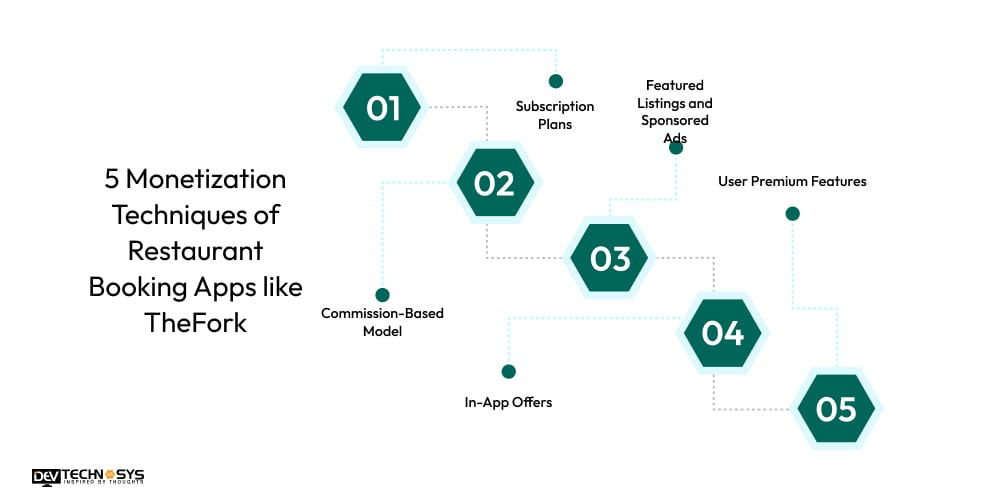
1. Subscription Plans
The best app to book restaurants provides premium options for restaurants seeking increased visibility or access to advanced capabilities. These monthly or annual subscriptions may include analytics dashboards, promotional spots, priority listing, and CRM interfaces. This regular income supports the platform while providing value to business partners.
2. Commission-Based Model
Many booking apps like Glovo rely on this as their principal source of revenue. Every time a user makes a reservation via the app, the platform charges the restaurant a commission fee. This might be a set fee per booking or a percentage of the anticipated bill amount.
3. Featured Listings and Sponsored Ads
Restaurants can pay to appear in “Featured” sections or at the top of search results, which increases visibility. Sponsored advertising is a popular technique to monetise high-traffic portions of an app while maintaining user experience.
4. In-App Offers
TheFork clone apps sometimes charge restaurants to conduct special deals or time-sensitive promotions through the app. According to the iPhone app development company, these arrangements increase bookings and can be a source of revenue for the platform, particularly when combined with a performance-based approach. As a trusted B2B platform, such apps not only connect restaurants with more diners but also offer them targeted tools to grow their business efficiently
5. User Premium Features
Though less popular, some app to book table in restaurant charge a modest membership fee for premium user benefits such as early access to bookings, VIP booking choices, or ad-free experiences, which adds another source of money.
Conclusion
Developing the best app for restaurant booking like TheFork requires a smart mix of user-focused features, the right tech stack, and a solid monetization strategy. With the growing demand for digital dining solutions, it’s the perfect time to bring your idea to life. From real-time bookings to loyalty programs, every detail matters. To ensure success, partner with an experienced food delivery app development company that understands the industry and can turn your vision into a powerful, user-friendly platform. The future of dining is digital, start building it today!
Frequently Asked Questions
Q1. How Much Does It Cost To Develop a Restaurant Booking App like TheFork?
The cost to build a restaurant booking app like TheFork ranges from $8,000 to $25,000, depending on the features, platforms, design complexity, and the location and experience of your development team.
Q2. How Long Does it Take to Create a Restaurant Booking App like TheFork?
To create a restaurant booking app like TheFork, it typically takes 3 to 6 months, depending on feature complexity, design requirements, platform choice, and the size and efficiency of the development team.
Q3. Which Technology Stacks Are Used to Make a Restaurant Booking App like TheFork?
To make a restaurant booking app like TheFork, use technology stacks including React Native or Flutter for mobile, Node.js or Django for backend, PostgreSQL or MongoDB databases, Firebase for real-time updates, and Stripe for payments.
Q4. How To Maintain And Update The App Post-Launch?
Maintain your app post-launch by regularly fixing bugs, updating features, ensuring compatibility with new OS versions, monitoring performance, responding to user feedback, and providing ongoing customer support for a smooth experience.
Q5. How To Handle Cancellations And Modifications In Bookings?
Handle cancellations and modifications by providing users with an easy, transparent interface to update bookings, sending instant notifications to restaurants, enforcing clear cancellation policies, and allowing flexible rescheduling options to enhance user satisfaction.
